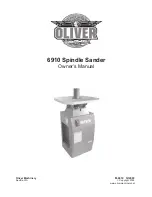
www.scheppach.com /
+(49)-08223-4002-99 /
+(49)-08223-4002-58
22 | GB
5) Service
a)
Have your power tool serviced by a qualified
repair person using only identical replace-
ment parts.
This will ensure that the safety of the
power tool is maintained.
Warning!
This electric tool generates an electro-
magnetic field during operation. This field can impair
active or passive medical implants under certain
conditions. In order to prevent the risk of serious or
deadly injuries, we recommend that persons with
medical implants consult with their physician and the
manufacturer of the medical implant prior to operat-
ing the electric tool.
Additional safety rules for the belt and disc
sanding machine
Warning: Do not use your machine until it is com-
pletely assembled and installed according to the in-
structions.
• If you are not familiar with the operation of the
sanding machine, ask the head of the department,
your teacher, or any other qualified person.
• Attention: This machine has only been designed
for sanding wood or similar materials. The sand-
ing of other materials can cause fire, injuries, or
damage the product.
• Always wear safety goggles.
• This machine may only be operated indoors.
• Important: Mount and use the machine on a hori-
zontal surface. A non-horizontal surface can dam-
age the motor.
• If the machine tends to tilt or walk (especially when
sanding long and heavy panels), it must be fas-
tened to a solid surface of sufficient carrying force.
• Make sure the sanding belt runs in the correct di-
rection – see arrows at the back of the belt.
• Make sure the sanding belt is running correctly so
that it cannot come off the drive pulleys.
• Make sure the sanding belt is not twisted or loose.
• Firmly hold the workpiece when sanding.
• Always use the fence when using the sanding ma-
chine in horizontal position.
•
Always hold the workpiece firmly to the table when
using the sanding disc.
• Always hold the workpiece to the side of the sand-
ing disc running downwards, in order to maintain
the workpiece pressed to the table. By using the
upward-running side of the sanding disc, the work-
piece could be ejected and cause injury to per-
sons.
• Always keep a minimum distance of about 1.5 mm
or less between the table or fence and the sand-
ing belt or disc.
• Do not wear gloves. Do not hold the workpiece
with a cloth during sanding.
g) If devices are provided for the connection of
dust extraction and collection facilities, en-
sure these are connected and properly used.
Use of dust collection can reduce dust-related
hazards.
h) Do not let familiarity gained from frequent use
of power tools allow you to become compla-
cent and ignore power tool safety principles.
A careless action can cause severe injury within a
fraction of a second.
4) Power tool use and care
a) Do not force the power tool. Use the correct
power tool for your application.
The correct
power tool will do the job better and safer at the
rate for which it was designed.
b) Do not use the power tool if the switch does
not turn it on and off.
Any power tool that can-
not be controlled with the switch is dangerous and
must be repaired.
c) Disconnect the plug from the power source
and/or remove the battery pack, if detach-
able, from the power tool before making any
adjustments, changing parts of insert tools,
or storing power tools.
Such preventive safety
measures reduce the risk of starting the power
tool accidentally.
d) Store idle power tools out of the reach of chil-
dren and do not allow persons unfamiliar with
the power tool or these instructions to oper-
ate the power tool.
Power tools are dangerous in
the hands of untrained users.
e) Maintain power tools and insert tools. Check
for misalignment or binding of moving parts,
breakage of parts and any other condition
that may affect the power tool’s operation. If
damaged, have the power tool repaired before
use.
Many accidents are caused by poorly main-
tained power tools.
f) Keep cutting tools sharp and clean.
Properly
maintained cutting tools with sharp cutting edges
are less likely to bind and are easier to control.
g) Use the power tool, accessories and tool bits
etc. in accordance with these instructions,
taking into account the working conditions
and the work to be performed.
Use of the power
tool for operations different from those intended
could result in a hazardous situation.
h) Keep handles and grasping surfaces dry,
clean and free from oil and grease.
Slippery
handles and grasping surfaces do not allow for
safe handling and control of the tool in unexpect-
ed situations.











































